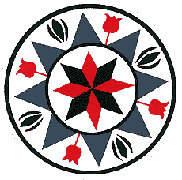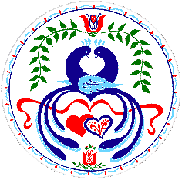

 Pennsylvania Dutch Cookery is one of the oldest and most distinctive of the many regional styles of cooking in the United States. The Rhine and Palatinate peoples, who came to this country and settled in Pennsylvania beginning in 1683, were
properly called Pennsylvania Deutsch because of their German origin. Popular use of the word, "Deutsch", changed it to
"Dutch" and that is the accepted term today. The PA Dutch brought with them a love of good food as well as a knowledge of good cooking. Recipes from the old country were adapted to use the limited ingredients available in a pioneer land.
Pennsylvania Dutch Cookery is one of the oldest and most distinctive of the many regional styles of cooking in the United States. The Rhine and Palatinate peoples, who came to this country and settled in Pennsylvania beginning in 1683, were
properly called Pennsylvania Deutsch because of their German origin. Popular use of the word, "Deutsch", changed it to
"Dutch" and that is the accepted term today. The PA Dutch brought with them a love of good food as well as a knowledge of good cooking. Recipes from the old country were adapted to use the limited ingredients available in a pioneer land.
As the thrifty, hard working PA Dutch farmers became more prosperous, their fields, flocks and herds provided the flour,
butter, eggs, and milk they used so lavishly in their cooking.
Early PA Dutch settlers produced almost everything they used on their own farms. They bought little except salt and a few spices.
Early PA Dutch cooks were most ingenious in their methods of food preservation--smoking, drying, brining, and pickling a wide variety of foods with great skill. They made wide use of dried fruits in their cooking, particularly the dried sweet apple or schnitz.
Modern PA Dutch families have inherited a liking for many of the traditional dishes. The treasured recipes and cooking skills have been passed from mother to daughter for generations. It is sometimes difficult to transfer these recipes to standard measurements as they are likely to call for a pinch of this and a drizzle of that, "butter the size of a walnut," "flour to stiffen," or "potatoes enough to fill a pig stomach."
Dough is used extensively in PA Dutch Cooking. Rivels, noodles, dough balls, and all kinds of dumplings are used in soups, meat dishes, with vegetables and even in desserts, such as cherry, rhubarb, or berry dumplings.
Raised dough is baked in loaves or made into coffee cakes, sticky buns, sugar cakes, rolls as well the German kuchen. Recipes for raised dough vary in proportions, but many of them call for mashed potatoes. These potato doughs are very light and moist.
Special doughnuts called fastnachts are made for Shrove Tuesday.
There are sectional differences in PA Dutch Cookery. Counties, communities, or even neighbors may differ in the recipes they use. Some like a moist molasses layer in their Shoofly Pie, others prefer a cakelike texture all the way through. Some use rivels in Chicken Corn Soup, others use a noodle-like dough cut in small squares. My grandmother used Saffron as a spice in many chicken dishes, like Chicken Pot Pie. Other PA Dutch areas didn't use the spice at all. Saffron is the only thing to an exotic spice used by some PA Dutch. All typical PA Dutch food is plain, hearty ("sticks to your ribs"), is served "family style" with plenty for everyone, even a drop-in guest. And, it is "wonderful good!"
MEATS: The typical PA Dutch meat dishes use many of the less tender cuts of meat as well as some of the organ and grandular meats, which is rather unusual but fitting as they hate to waste anything, let alone something so nutritious. Tripe, liver, and pig stomach are some of their favorite dishes. Pork scraps are used along with liver, corn meal, and sometimes kidney to make scrapple or ponhaus.
Dough and potatoes are often used in combination with meat in pot pie. It is made in a kettle on top of the stove, not baked in an oven. Most popular meats are beef and chicken (or turkey). Pot pie is often made with leftover meat and broth. The dough is rolled out thin and cut into squares, and put one at a time into the boiling broth so they don't stick together. All you add is a little onion, some cut up celery, and some potatoes. "Gut essen!"

VEGETABLES: Potatoes are a favorite food of the PA Dutch and they are prepared in many different ways. In some places they are served three times a day, starting with fried or hash browned for breakfast.
Cabbage, corn, beans, sugar peas, and Jerusalem artichokes are other vegetables most commonly used. Beets are usually pickled and much of the cabbage is served as sauerkraut.
Potato filling may be used for stuffing a chicken or turkey, but is often served as a side dish (along with the regular stuffing).
There are many PA Dutch recipes for hot potato salad. Instead of lettuce type salads, many times the PA Dutch serve corn salad, bean salad, or chow chow which are made of cooked vegetables with sugar and vinegar added.
Noodles and dumplings are counted as vegetables by the PA Dutch cook. It was very important to have plenty for everyone to eat.
SALADS: Fresh greens were available only a few months of the year in the early days of the PA Dutch. Therefore, only a few salads are typical. These few are well worth eating and have become popular outside the PA Dutch region.
Hot bacon dressing, sweet cream and vinegar dressing, and sour cream dressing are the three types of dressings most commonly used. Fresh young dandelion, leaf lettuce, cabbage, sweet pepppers, endive, and cucumbers are the salad materials used, singly or in combination of only two as in pepper cabbage.
 SWEETS & SOURS: Pickles, relishes, preserves, and spiced fruits are served as accompaniments or appetizers in many kinds of regional or national cookery. No other style of cookery offers such a wide variety or has the idea of "seven sweet and seven sours" which is common at PA Dutch Dinners. It is more important that the "sweets and sours" are delicious and plentiful than the actual number of each.
SWEETS & SOURS: Pickles, relishes, preserves, and spiced fruits are served as accompaniments or appetizers in many kinds of regional or national cookery. No other style of cookery offers such a wide variety or has the idea of "seven sweet and seven sours" which is common at PA Dutch Dinners. It is more important that the "sweets and sours" are delicious and plentiful than the actual number of each.
Some of the most typical sweets are apple butter, spiced canteloupe, cinnamon apples, kimmel cherries, ginger pears, spiced fruits of all kinds. Also available was a wide variety of perserves, jams, jellies, and butters of many kinds of fruits. A favorite way of eating apple butter is on bread with cottage cheese or schmierkase.
Favorite sours included cabbage-filled peppers, pickled cabbage,
chow chow, pickled beets (and pickled eggs), pickled mushrooms,
bean and corn salad, as well as many different kinds of pickled cucumbers.
 DESSERTS: Cakes, cookies, puddings and custards are plentiful in PA Dutch cooking. It is in the making of pies that the PA Dutch excel. They used to make pies daily with whatever ingredients were available. In the summer there were plenty of berries for pies. In the fall, there were apples for pies and apple dumplings. In the winter, when other things were unavailable, there were always Shoofly Pies, and pies made from dried fruits: raisins, dried apples (schnitz), or apricots. Raisin pie became known as funeral pie as it was always served at the big meal following a funeral. Pie was also considered good to eat for breakfast with milk poured over it. Unconventional, yes, but very tasty.
DESSERTS: Cakes, cookies, puddings and custards are plentiful in PA Dutch cooking. It is in the making of pies that the PA Dutch excel. They used to make pies daily with whatever ingredients were available. In the summer there were plenty of berries for pies. In the fall, there were apples for pies and apple dumplings. In the winter, when other things were unavailable, there were always Shoofly Pies, and pies made from dried fruits: raisins, dried apples (schnitz), or apricots. Raisin pie became known as funeral pie as it was always served at the big meal following a funeral. Pie was also considered good to eat for breakfast with milk poured over it. Unconventional, yes, but very tasty.

Recipes will follow as I have time to write them out, but if you would like a special recipe, let me know. PA Dutch Cookery includes recipes from the Amish and Mennonite people as well as other
plain folks living in South Central PA. My own expertise is from PA Dutch foods from Lancaster County (and a little Lebanon County
mixed in). My ancestors were from Germany and Switzerland.
Much of this information was from the Penn State University, Extension Service, Circular 348, "Pennsylvania Dutch Cookery."
Lititz native, Edna Eby Heller wrote the cookbook: The Art of Pennsylvania Dutch Cooking, 1968
Edna also wrote the smaller booklet,
The Pennsylvania Dutch Cookbook in the late 1960s.
Eat Yourself Full, Pennsylvania Dutch Cookery for Feinschmeckers* by Ruth R. Tyndall, 1967
*Feinschmecker-someone who knows what good is.
These cookbooks are now out of print, but can be found at bookstores that deal with old books. If you like old recipes, they are well worth finding a copy.

Another recommended book on PA Dutch Cooking is "Mennonite Community Cookbook" by Mary Emma Showalter. Where else can you get the recipe for homemade Grape Nuts? Or, a food list for a Barn Raising (like the one shown in one of my favorite movies, "Witness," which was filmed in beautiful Lancaster County, PA).
Be sure and visit Root's Market is where my grandma and grandpa bought whatever fresh produce they didn't grow themselves. It's nice to know they are still in business today.
© 1997 Jann's PA Dutch Kitchen
Updated 2004